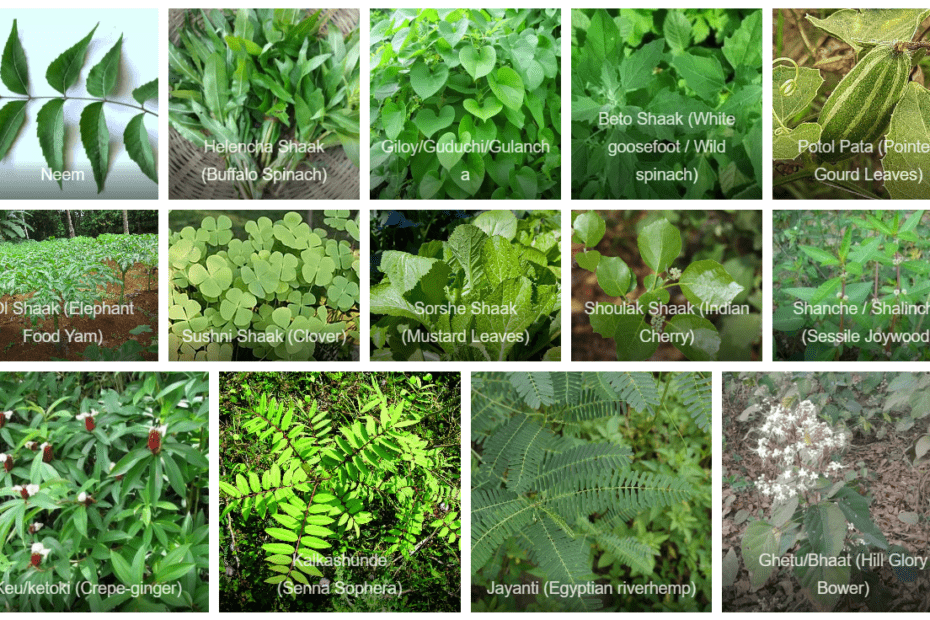About The Author
Hello! From Chuchura (in Hooghly District) and a foodie, I created this blog with a mission to preserve the food of the land; with a message to encourage and promote clean and real food. I hope you enjoy and gain out of this blog, happy reading!
Looking forward to read and hear your feedback.
tl;dr : This article is a celebration of the rituals followed a day before Kali Pujo which includes consuming choddo shaak or fourteen different leafy greens for lunch and lighting fourteen lamps in the evening. It explains the spiritual and scientific reasons that make these rituals important.
A day before Kali Pujo, Bengalis (and I guess several Hindu communities within India) are a busy lot – the house needs to be lit up with lamps, candles and LEDs; there is a lot of preparation going on for the pujo (puja) of Goddess Kali, or Goddess Lokkhi.
Before all these can happen, the morning is reserved to find and then cook the choddo shaak or the fourteen leafy greens.
The day before Kali Pujo is locally called as Bhoot Chaturdashi. “Bhoot” translates to “past” or “ghost” or something that does not exist today. And “chaturdashi” means “fourteen”.
Bhoot Chaturdashi is a Bengali observance which occurs on the 14th day of Krishna Paksha (waning phase of moon) in the month of Kartik (according to Bengali Hindu calendar).
This is a time of transition – from post monsoon autumn to the beginning of the winter, with the festival of Kali Pujo acting as the divine junction between the two seasons.
Bhoot choturdoshi marks two important rituals in Bengali households –
- Eating fourteen types of leafy greens (or choddo shaak) for lunch
- Lighting of fourteen earthen lamps in the darkest corners of the house
Folklore Around the Choddo Prodeep (Fourteen Lamps)
On the occasion of bhoot choturdoshi, come evening, and it is customary for Bengalis to light fourteen lamps in the evening. The rule is to find the darkest spots and ensure that there is light.
The tradition calls for usage of ghee and cotton wicks. However, ghee is expensive and oil has replaced it. Sadly, even the oil sold for this purpose is of subpar quality, impacting our health. It is recommended to use edible oil and if possible, stick to ghee
Customs and rituals are never without folklore – and the choddo prodeep is no exception. There are several folklore around this practice.
One mentions that on the eve of Kali Pujo, our ancestors visit us to protect us from evil spirits and bless us.
The Bengali word for ‘ancestors’ is ‘choddo-purush‘, meaning 14 ancestors (7 from each side) and hence the fourteen lamps. It is said that the light from these lamps help them find their loving homes.
Bhoot chaturdashi is a way to pay homage to our ancestors.
A second folklore goes like this – Chamunda along with fourteen other ghostly forms protect the house from evil spirits and ghosts.
Another popular belief is that on the eve of Kali Pujo, there is a heightened activity in the tantrik community.
It is believed that these tantrik kidnap young children and sacrifice them to gain dark magic powers. Lighting fourteen lamps thus keep the children busy at home and prevent them from moving out.
The goal is to ensure that the lamps remain lit for as long as possible into the night.
In Bengal, a popular local belief is that the Goddess Kali herself descends on earth with 14 spirit attendants before she embarks on a mission to defeat the unholy (and evil) spirits.
The Choddo Shaak (14 Types of Leafy Greens) Ritual
The custom of eating choddo shaak (or fourteen types of leafy greens) is a ritual of celebrating the enormous variety of uncultivated greens in our surroundings and its immense nutritional and environmental importance.
In the yesteryears, Bengal was extremely rich and prosperous in natural resources (I believe it still is); where a lot of edible leafy greens naturally grew in the homestead gardens or home surrounding areas like roadsides, ditches, ponds, canal banks or field bunds. The women folk of the house would venture out every morning and collect them for the day’s lunch.
As per the practice followed by the Bengali community, leafy greens should always be consumed only during the day (for lunch). It should never be consumed for dinner, or after sunset. According to ayurveda, with sunset our digestion power starts slowing and hence we should not eat anything that our body finds difficult to digest/metabolize.
In a traditional Bengali lunch, the meal always started with something astringent and bitter. Leafy greens have an inherent astringent/bitter taste, and a few different types of leafy greens always adorned the Bengali thali.
Not anymore today, where one item of leafy greens is considered the norm!
However, on bhoot chaturdashi, the custom is still present outside urban Bengal (read Kolkata). The roles have changed, though.
Since we all live in smaller homes with minimal/no greenery around, the menfolk are tasked with going to the market and buying fourteen different types of leafy greens that is either of the best quality or one that does not dig a hole in the pocket.
It is sold as a bundle in the local market for the occasion.
Barnali Dutta notes in her blog, “these precious herbs surface only on this day since they are incorporated into the ritual ingredients and is not to be seen throughout the rest of the year. Thus, our forefathers made efforts to lock these very special [best] herbs of Bengal forever in the form of rituals since they were worried that these would become extinct otherwise and also being a ritual this would be followed by everyone… A thing to notice is that have we been able to take any such measure for our future generations?
How the Choddo Shaak Ritual Began
In modern Bengali language, the word shaak means leafy greens.
In ayurveda, the word shaak was traditionally used to denote six different types of greens.
Rigveda mentions of a place called Shaakdwip located in eastern India where folks used to rely on mostly greens instead of meat in the diet. These group of people later spread to other regions and came to be known as ‘Shaakdwipi Brahmins’ due to their food habit.
Food blogger Ranjini mentions in her blog, that the 13th verse of chapter 84 of ‘Banaparba’ of Mahabharata mentions that Yudhisthira had visited ‘Shakambhar Tirtha’, a place in Shaakdwip where Shakhambhari Debi (a local deity) was offered shaak or six different types of greens. The deity was worshipped by serving debi shaak for fourteen days (meaning choturdosh in Sanskrit).
However, there was no mention regarding the season of this ritual.
The first mention about the ritual of eating choddo shaak on bhoot chaturdashi is found in Krityatatta (Krityatattva,Kṛtyatattva), written by Bengali Sanskrit scholar Raghunandan (born in Nabadwip).
Ayurveda, Science & Consuming Leafy Greens
The practice of consuming leafy greens has been documented in ancient scriptures such as Charaka Samhita (c. 700 B.C.E.).
During the rainy season, our body tends to become numb and cold.
Charaka Samhita states that as monsoon ends and autumn sets in, the sudden change in weather warms our heat-starved cold body (due to lack of sunlight) from the monsoon. This sudden change may lead to pitta imbalance, which may cause various infectious diseases.
To stay safe and avoid a bile upsurge, sages have advised us to consume greens. These herbs have the potential to keep such diseases at bay. This Ayurveda advice is believed to be the origin of the ritual of choddo shaak.
As scriptures note, it enables us to break free from the pull of “Kartik”, the Bengali pre-winter month. Every entrance leading to the residence of Jom (Yam), the God of Death, is left open throughout the Kartika season.
Note the clear reference to God to strongly suggest a ritual to keep a healthy body.
In Markandaye Purana (7th century C.E.), the eulogy of Shakambhari Durga describes how Debi created greens, tubers, and fruits from her body to save and feed the world from famine.
The Several Health Benefits from Consuming the Leafy Greens
It is although well-known that leafy greens possess a horde of health benefits, following are the several health benefits from consuming leafy greens.
- Loaded with minerals and vitamins specially carotene, folic acid, vitamin C, K, iron, calcium, potassium etc.
- Protects liver, keep liver enzyme (SGPT, SGOT, ALP) level under control.
- Rich in antioxidants, soluble and insoluble dietary fiber – keeps the gut healthy.
- Contain antimicrobial, anti-fungal, antihistaminic, anti-inflammatory properties.
- Keeps body hydrated, aids in weight loss and protects the eyes.
- Act as natural detox and helps to destroy worms in the body, prevent skin rashes, pimple, acne outbreak.
- Improves constipation by aiding in bowel movement.
- Low on glycemic index thus control blood sugar
- Boosts overall immunity.
The 14 Leafy Greens of Choddo Shaak Ritual
In the Bengali culture, leafy greens are proscribed and avoided during the monsoons because of two reasons –
- Muddy water, constant rainfall increases humidity which lead to higher manifestation of worms and insects on leafy greens. This makes cleaning leafy greens a daunting task. Small herbs remain submerged in the dirty water and hence insects also hatch eggs on the leaves which may not be always visible to the naked eye during cleaning/washing.
- Digestion is poor/weaker during the season.
Leafy greens are nutritious to the body. After a long break, we Bengalis resume the inclusion of leafy greens in our diet through this custom, in order to prepare our body from the coming onslaught of the winter – by increasing immunity and preventing/tackling winter diseases like seasonal flu and viral fever.
In the Bengali Hindu community, leafy greens can be consumed from the end of the monsoon season till the beginning of the next monsoon season.
Traditionally, the leafy greens have been used for medicinal purposes in traditional medicine as a way of strengthening the body’s immune system.
Choddo Shaak as Per Bengali Panjika

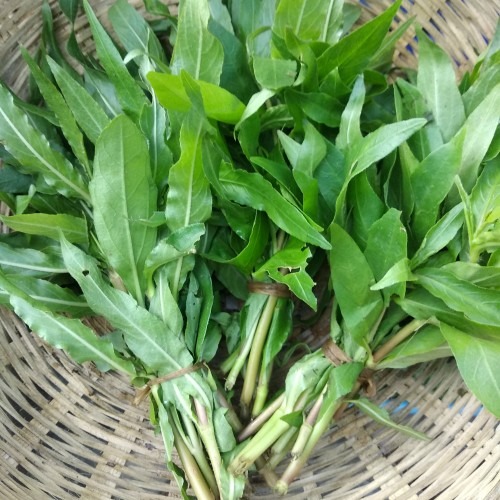
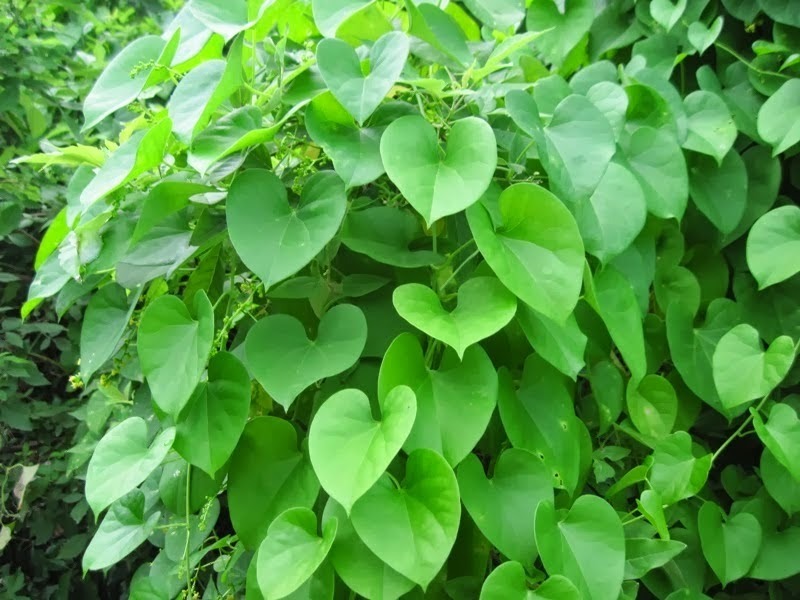


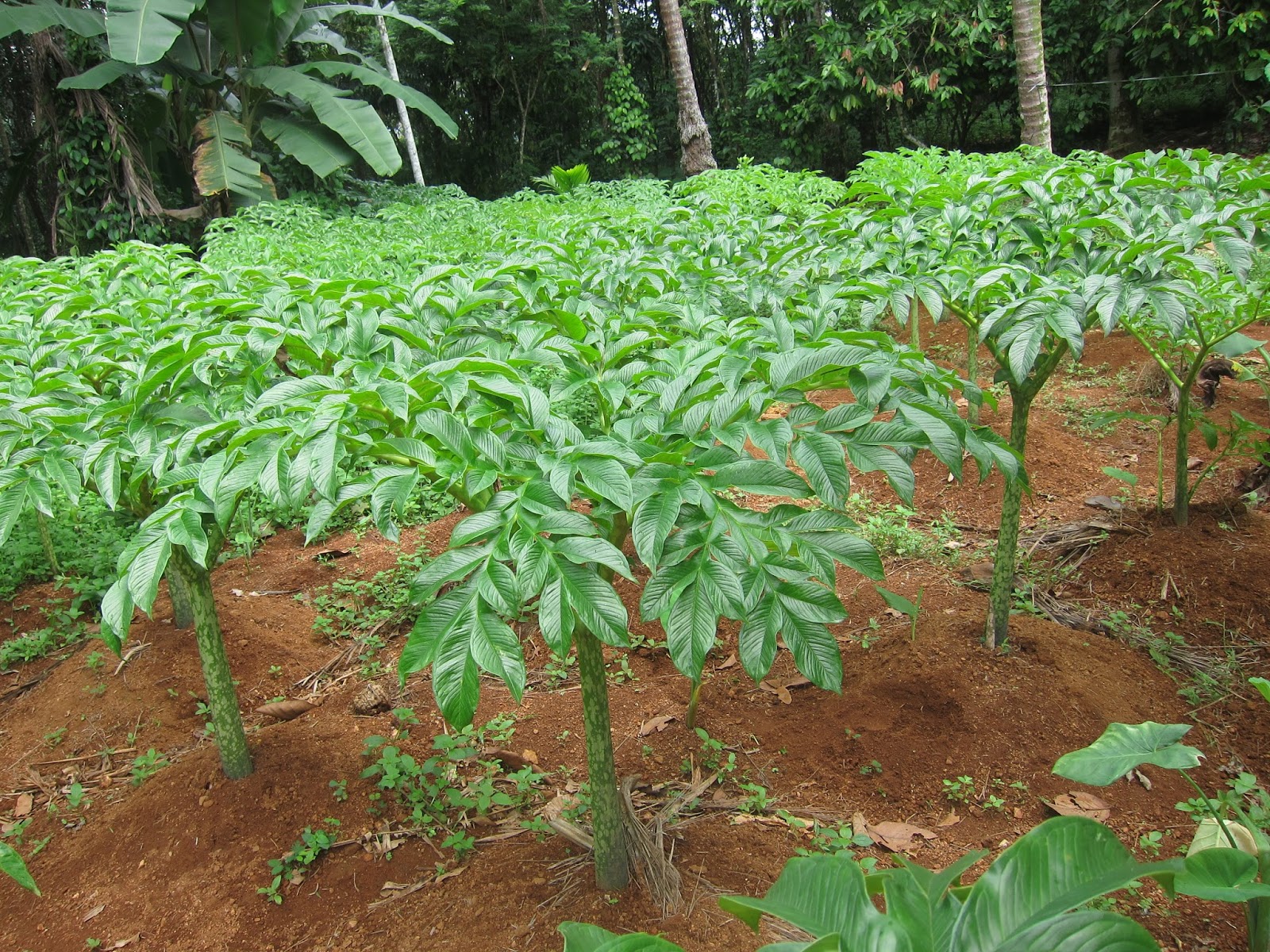


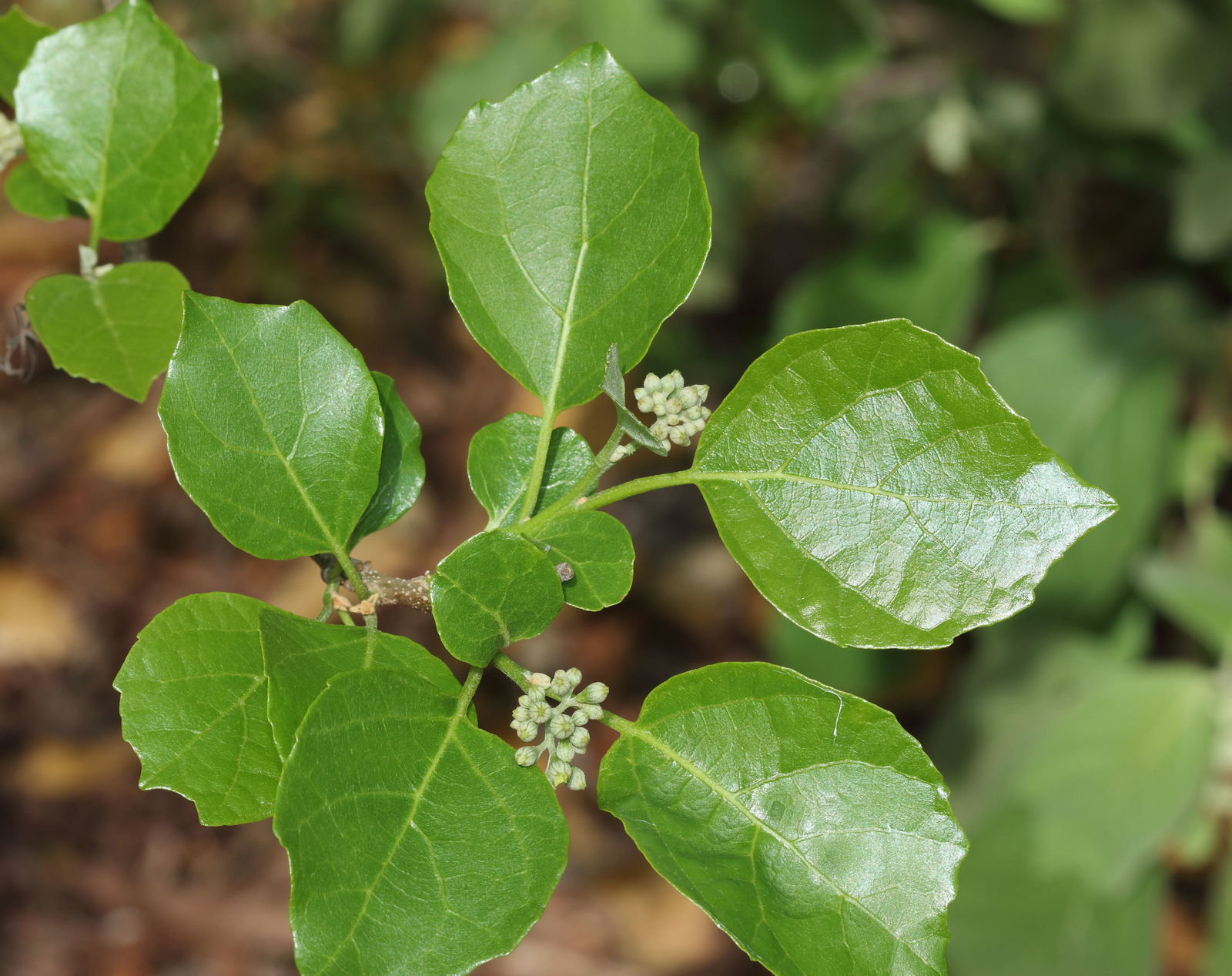
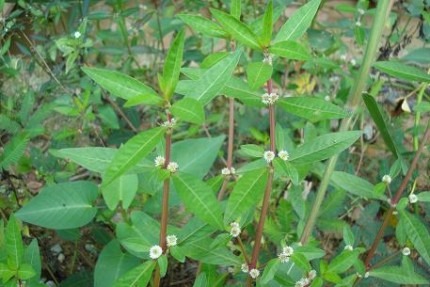


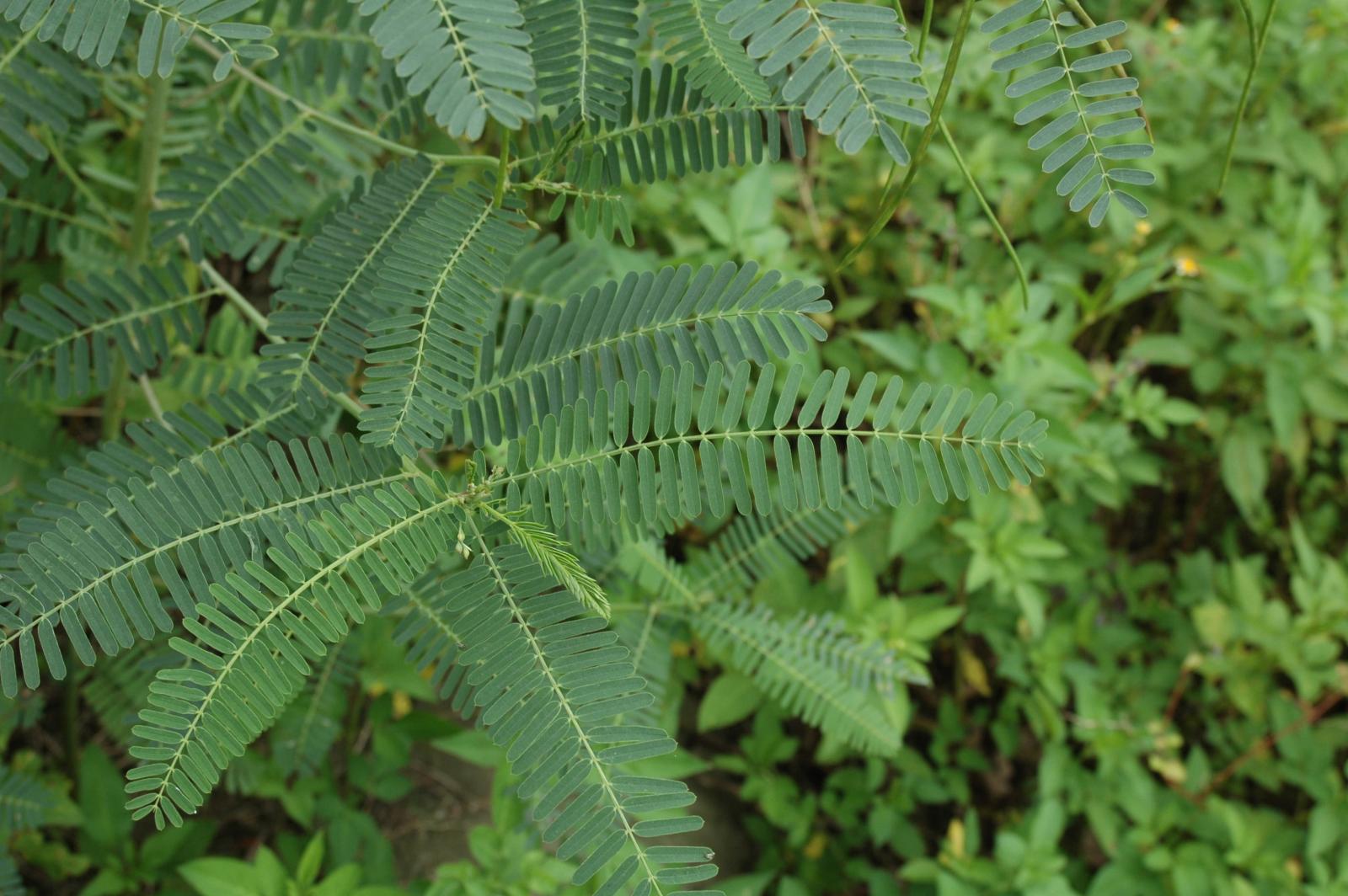
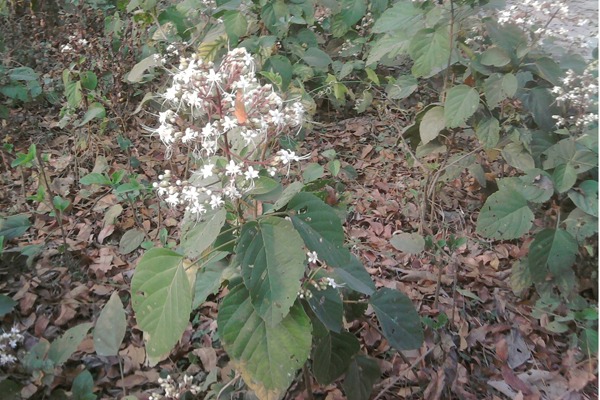
As per Bengali Hindu panjika (calendar), the following is a list of 14 leafy greens that Bengalis must consume on bhoot chaturdashi.
| Common Name | Bengali Regional Name | Scientific Name |
|---|---|---|
| Neem | Neem (নিম) | Azadirachta indica |
| Mustard | Sorshe (সর্ষে) | Brassica campestris |
| Elephant Foot Yam | Ol (ওল) | Amorphophallus paeoniifolius |
| Guduchi / Giloy | Gulancha (গুরুচী/ গুলঞ্চ) | Tinospora cordifolia |
| Pointed Gourd | Potol (পটল) | Trichosanthes dioica |
| Buffalo Spinach | Helencha/Hinche (হিঞ্চে) | Enhydra fluctuans |
| Water Clover/Clover | Sushni (শুষনি) | Marsilea quadrifolia |
| Crepe-ginger | Keu/ketoki (কেউ) | Costus speciosus |
| White goosefoot / Wild spinach | Beto/Bethua (বেতো) | Chenopodium album |
| Senna Sophera | Kalkashunde / kashunde (কালাকাসুন্দে) | Cassia sophera |
| Sesban / Egyptian riverhemp | Jayanti (জয়ন্তী) | Sesbania sesban |
| Sessile Joywood | Shanche / Shalinche (শালিঞ্চ / সাঞ্চে) | Alternanthera sessilis |
| Indian Cherry / Bird Lime | Shoulak/Sheluka Pata (শেলুকা) | Cordia dichotoma |
| Hill Glory Bower | Ghetu (ঘেটু / ভাট / ভন্টাকি) | Clerodendrum infortunatum |
In reality, it can be quite tough to get your hands on all of them during the occasion.
First, most people are ignorant about what each of these leafy greens look like. Secondly, many of these may not be available locally any longer, thanks to rapid urbanization and carelessness of the general population.
We should preserve our culture and heritage! The importance of the above-mentioned leafy greens should be discussed more in the public domain to revive their local availability.
Choddo Shaak Commonly Available Today
Today, folks follow the custom while adapting to the other leafy greens available in the market. Some of them are listed below.
| Common Name | Bengali Regional Name | Scientific Name |
|---|---|---|
| Spinach | Palong Shak (পালং শাক) | Spinacia oleracea |
| Red Amaranth | Lal Shak (লাল শাক) | Amaranthus cruentus |
| Water spinach | Kolmi Shak (কলমি শাক) | Ipomoea reptans |
| Mustard Leaves | Shorshe Shak (সর্ষে শাক) | Brassica juncea |
| Radish leaves | Mulo Shak (মুলো শাক) | Raphanus sativus |
| Malabar spinach | Pui Shak (পুঁই শাক) | Basella alba |
| Fenugreek leaves | Methi Shak (মেথি শাক) | Trigonella foenum-graecum |
| Tender jute leaves | Paat Shak (পাট শাক) | Corchorus olitorius |
| Bengal gram leaves | Chola Shak (ছোলা শাক) | Cicer arietinum |
| Helencha leaves | Hincha/ Helencha Shak (হিঞ্চা শাক) | Enhydra fluctuans |
| Bottle gourd leaves | Lau shak (লাউ শাক) | Lagenaria siceraria |
| Pumpkin leaves | Kumro shak (কুমড়ো শাক) | Cucurbita pepo |
| Colocasia leaves | Kochu Shak (কচু শাক) | Colocasia esculenta |
| Indian Pennywort | Thankuni Pata (থানকুনি পাতা) | Centella asiatica |
| Amaranth | Notey Shak (নোটে শাক) | Amaranthus gangeticus |
| Wild spinach | Beto Shak (বেতো শাক) | Chenopodium album |
| Water Clover/Clover | Shushni Shak (শুষনি শাক) | Marsilea minuta |
| Elephant Foot Yam | Ol (ওল শাক) | Amorphophallus paeoniifolius |
| Neem leaves | Neem Pata (নিম পাতা) | Azadirachta indica |
| Pointed gourd leaves | Polta / Patol Pata (পটল পাতা) | Trichosanthes dioica |
Prepping and Cooking the Choddo Shaak
Cooking the choddo shaak is simple and easy –
With leafy greens, do not compromise on hygiene. Discard the bad leaves and all the suspicious portions.
- Wash the leafy greens thoroughly. You will need to change water multiple times.
- Lightly drain all the excess water and chop them. Keep aside
- In a wok, add mustard oil and allow it to smoke
- (Optional) Fry dried lentil dumplings (locally called as bori) and keep separate
- In the same oil, add nigella seeds
- Once the seeds splutter, add some chopped garlic. Garlic is optional.
- Throw in the chopped leafy greens
- Add salt and turmeric powder, give it a nice stir
- Cook covered on a low flame
- Once leafy greens are cooked, add the fried lentil dumplings (bori) and slit green chilis
- Give it a stir and serve hot with rice and ghee
Embrace Your Culture
Culture is ever-evolving, however, many practices in Bengali Hindu community go back several centuries.
We must make every attempt to learn about, embrace, preserve, and protect our culture.
Through rituals and practices, we preserve our roots. We maintain a connect with our ancestors. Most importantly preserve the nature.
Have you noticed how most rituals we practice does not harm but preserve the ecology around us?
Personally, I believe that certain rituals and cultural practices must be followed to achieve a healthy being – a culmination of mind, body and soul. The rituals of bhoot chaturdashi are significant.
It is fine if you are not a practicing Hindu. You can always observe the day by lighting fourteen (earthen) lamps or candles and putting leafy greens on your plate.
It is indeed a celebration of light, remembering our roots and caring for our health!
